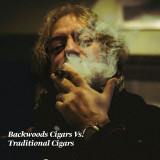Backwoods vs Traditional Cigars: Flavor & Experience

Cigars are celebrated for their unique flavors, meticulous craftsmanship, and cultural significance. Among the most debated types are Backwoods Cigars and Traditional Cigars. This article compares their flavor profiles, construction, smoking experiences, and value to help novices and aficionados choose a cigar that best suits their palate and lifestyle.
What Are Backwoods Cigars? Overview, History, and Construction
Backwoods Cigars are known for their rustic appearance and bold flavor. They feature dark, wild-looking wrappers that mimic natural tobacco leaves. Originating from a laid-back, outdoor style, these cigars use a less uniform mix of filler, binder, and wrapper. Often machine-made or semi-handmade, their irregular construction produces an unpredictable burn and evolving flavor, with notes reminiscent of rum, vanilla, or even piña colada.
How Did Backwoods Cigars Originate and Evolve?
Born in the American South, Backwoods emerged from a culture emphasizing rugged individualism and casual smoking. Early manufacturing methods focused on practicality rather than perfection, resulting in a robust, unpolished smoke that many enthusiasts appreciate for its authenticity.
What Types of Backwoods Cigars Are Available?
Backwoods are offered in various blends and sizes to match diverse tastes. Options range from the classic full-bodied, earthy version to flavored varieties with hints of cognac, bourbon whiskey, or even piña colada-like sweetness. Some are filtered for a smoother draw while others are unfiltered for a more dynamic flavor profile.
How Are Backwoods Cigars Constructed?
Their construction involves loosely packed filler tobaccos combined with a binder and a naturally treated wrapper that simulates wild tobacco leaves. This relaxed assembly results in a more open draw and irregular burn, and while not as precise as premium hand-rolled cigars, it enhances the sense of authenticity and rustic charm.
What Defines Traditional Cigars? Types, Regions, and Craftsmanship
Traditional Cigars represent premium smoking, defined by strict quality control, consistent construction, and layered flavors. They are the result of careful aging, fermenting, and meticulous hand-rolling, ensuring a balanced, refined, and consistent smoking experience. Their construction techniques and blended tobaccos yield a complex profile with notes that may include caramel, vanilla, and subtle spices.
What Are the Main Types of Traditional Cigars?
These cigars come in various types such as machine-made premium and hand-rolled versions, with shapes including torpedo, robusto, corona, and cigarillos. Each type is engineered to deliver a specific concentration of flavor and a balanced smoke, catering to different intensity levels and preferences.
Which Regions Are Known for Traditional Cigar Production?
Countries like Cuba, the Dominican Republic, Nicaragua, and Honduras are renowned for traditional cigars. These regions contribute unique characteristics due to their local soil, climate, and centuries of tobacco expertise, making them synonymous with quality in the tobacco industry.
How Are Traditional Cigars Hand-Rolled and Constructed?
Hand-rolling is a skilled art performed by experienced torcedores who select, age, ferment, and assemble the tobacco with precision. This labor-intensive process ensures an even burn, optimal draw, and a carefully integrated flavor profile that reflects the rich heritage of brands such as Montecristo, Cohiba, and Romeo y Julieta.
How Do the Flavor Profiles of Backwoods and Traditional Cigars Compare?
Backwoods Cigars and Traditional Cigars deliver distinctly different flavor experiences. Backwoods offer a rugged, robust taste with hints of sweetness and natural earthiness, while Traditional Cigars provide a refined, layered profile with complex notes of caramel, vanilla, and spices. These differences are crucial for smokers seeking either an edgy experience or a smooth, sophisticated palate.
What Flavor Notes Are Common in Backwoods Cigars?
Backwoods are characterized by bold, unrefined tones with hints of rum, cognac, and occasional raspberry or piña colada-like sweetness. Their flavor tends to intensify as the smoke evolves, appealing to those who favor an authentic and dynamic smoking session.
What Are the Typical Flavor Characteristics of Traditional Cigars?
Traditional Cigars are celebrated for their balanced and nuanced profiles. They typically showcase tobacco, leather, and spice notes, along with subtle hints of caramel and vanilla. This complexity is enhanced through precise blending and careful fermentation, producing a smooth progression of flavors appreciated by discerning palates.
How Do Flavor Wheels Illustrate These Differences?
Flavor wheels for Backwoods display intense, raw notes such as earthiness and sweetness, whereas those for Traditional Cigars are segmented to highlight layers of spice, wood, and herbal undertones. These visual tools help smokers quickly grasp the comparative complexity and appeal of each type.
How Does the Smoking Experience Differ Between Backwoods and Traditional Cigars?
The smoking experiences differ mainly in their consistency and overall delivery. Backwoods offer a casual, spontaneous session marked by variable burn rates and unpredictable draws. In contrast, Traditional Cigars deliver a slow, methodical, and refined experience, with a focus on even burning and smooth progression of flavors.
How Do Burn Rate and Draw Compare?
Due to their construction, Backwoods Cigars may burn unevenly, sometimes resulting in a harsher taste if not managed properly. Traditional Cigars, with their precise construction and uniform filler, provide a steady burn and controlled draw that enhances flavor and minimizes harshness.
What Are the Differences in Aroma and Strength?
Backwoods typically emit a strong, immediate aroma that is both earthy and sweet, ideal for a bold smoking session. Traditional Cigars, however, exude a subtler, more evolving aroma that unfolds gradually, providing a measured strength that avoids overpowering the palate.
How Does the Overall Smoking Experience Vary?
Ultimately, Backwoods deliver a rugged, free-form experience appealing to those who seek variety and unpredictability. Traditional Cigars offer a consistently refined session, with gradual flavor layering and an overall elegant finish, making them well-suited to both casual and formal settings.
What Are the Construction Differences Between Backwoods and Traditional Cigars?
Construction differences are central to performance and flavor. Backwoods use a more relaxed and varied process which can result in a less predictable product, whereas Traditional Cigars benefit from rigorous selection, blending, and hand-rolling to ensure uniformity and consistency.
How Do Wrappers Differ in Backwoods vs. Traditional Cigars?
Backwoods wrappers are often natural and rugged, displaying imperfections and varying textures that contribute to an unpredictable burn. Traditional Cigars use carefully selected, uniform wrappers that not only enhance appearance but also support even burning behavior and reliable flavor delivery.
What Are the Differences in Filler and Binder Types?
The eclectic filler in Backwoods cigars leads to a variable flavor and draw, while the controlled, consistently blended filler and binder in Traditional Cigars guarantee smooth combustion and a balanced smoking experience. This attention to detail is a hallmark of premium cigar craftsmanship.
How Does Manufacturing Impact Quality and Experience?
Relaxed manufacturing methods for Backwoods emphasize authenticity and spontaneous flavor shifts, whereas the labor-intensive, hand-rolled techniques of Traditional Cigars ensure premium quality, consistent burn, and a sophisticated flavor integration.
How Do Price and Value Compare Between Backwoods and Traditional Cigars?
Price and value vary significantly between the two. Backwoods are usually more affordable due to simpler production methods, appealing to casual smokers. Traditional Cigars, made with premium materials and artisanal skills, command higher prices and are seen as an investment in long-term smoking quality and consistency.
What Is the Typical Price Range for Backwoods Cigars?
Backwoods generally fall into the lower to mid-price range, offering bold flavors and accessibility for social or casual settings without a significant financial outlay.
How Much Do Traditional Cigars Usually Cost?
Traditional Cigars occupy a higher price bracket owing to their meticulous construction; high-end brands can be considered luxury items. The extra cost is justified by their superior, consistent smoking experience and refined flavors.
Which Offers Better Value for Money?
The better value depends on personal preference. Those who favor immediate, robust flavor and affordability may choose Backwoods Cigars, while enthusiasts seeking a refined, consistent experience might prefer Traditional Cigars.
What Are the Pros and Cons of Backwoods Cigars Compared to Traditional Cigars?
Both types have advantages and limitations. Backwoods offer affordability, bold flavors, and authenticity but can suffer from inconsistencies. Traditional Cigars provide unmatched refinement and reliability, though at a higher cost and with a longer smoking session requirement.
What Are the Advantages of Choosing Backwoods Cigars?
Advantages include lower cost, robust, dynamic flavors, and a straightforward, unpretentious smoking experience. Their rustic construction, though variable, delivers an authenticity that many smokers find appealing.
What Are the Benefits of Traditional Cigars?
Traditional Cigars excel in consistency, quality, and complexity. The careful hand-rolling process ensures an even burn, smooth draw, and a sophisticated flavor evolution that caters to seasoned connoisseurs.
What Are the Limitations of Each Type?
Backwoods can exhibit unpredictable burn and draw due to less uniform construction. In contrast, Traditional Cigars are more expensive and typically require a longer smoking session, which may not suit casual smokers.
How Can Beginners Choose Between Backwoods and Traditional Cigars?
Beginners should consider their flavor preferences, budget, and desired smoking experience. Whether preferring the rugged spontaneity of Backwoods or the refined consistency of Traditional Cigars, sampling both types and consulting with a knowledgeable tobacconist can help in making an informed choice.
What Factors Should Beginners Consider?
Key factors include taste intensity, construction quality, burn consistency, draw, and the social context of smoking. Evaluating these elements will guide beginners to a choice that best matches their lifestyle and palate.
How to Match Cigars to Personal Tastes and Occasions?
For casual outings or lively gatherings, the bold, unruly flavor of a Backwoods Cigar might be ideal. In more formal or extended smoking sessions, the smooth, layered profile of a Traditional Cigar offers an elevated experience. Experimentation and personal preference play crucial roles in the selection process.
What Are Basic Cigar Smoking Etiquette and Storage Tips?
Proper storage in a humidor at around 65-70% humidity is essential to maintain moisture and flavor. When smoking, avoid directly blowing smoke on others, cut the cigar cleanly for an optimal draw, and enjoy the evolving flavors slowly to fully appreciate the unique profile.
Frequently Asked Questions
What makes Backwoods Cigars unique compared to Traditional Cigars?
Backwoods offer a rustic, unrefined flavor with a casual, unpredictable burn, whereas Traditional Cigars provide consistent, meticulously crafted experiences.
Which type is more suitable for a beginner?
Beginners might opt for Backwoods due to affordability and bold flavors, though some may prefer Traditional Cigars for their refined introduction.
How important is proper storage for maintaining cigar quality?
Extremely important – storing cigars in a humidor at 65-70% humidity preserves flavor and ensures a consistent burn.
Can the smoking experience influence the choice between these cigars?
Yes, whether one prefers a spontaneous, bold smoking session or a refined, consistent experience can determine the choice.
Do regional differences affect the flavor of Traditional Cigars?
Absolutely; cigars from Cuba, the Dominican Republic, Nicaragua, and Honduras exhibit distinct flavors influenced by local climate, soil, and craftsmanship.
Backwoods Cigars and Traditional Cigars each offer unique experiences tailored to different tastes and occasions. While Backwoods provide a bold, unrefined, and accessible smoking experience, Traditional Cigars deliver a refined, consistent, and complex flavor profile. The final choice depends on personal preference, budget, and the context in which the cigar is enjoyed. Smokers are encouraged to explore both to fully appreciate the rich diversity available in the world of cigars.
Recent Posts
-
Backwoods vs Traditional Cigars: Flavor & Experience
Cigars are celebrated for their unique flavors, meticulous craftsmanship, and cultural significance …11th Sep 2025 -
Best Cigar and Bourbon Pairings for Every Aficionado
Best Cigar and Bourbon Pairings for Every Aficionado Pairing a fine cigar with a glass of bourbon i …10th Sep 2025 -
Swisher Sweets Seasonal Flavors You Need to Try
In today's competitive tobacco market, swisher sweets has carved a niche with its innovative season …9th Sep 2025



